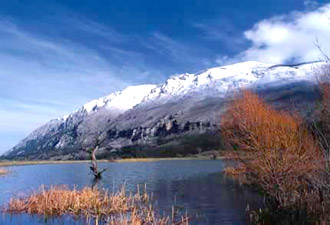| Dintorni |
|
Villa Sant’Andrea si trova al centro di un territorio ricchissimo di tradizioni, cultura e ambienti naturali che costituiscono un patrimonio enorme per la Sicilia: il territorio č caratterizzato dalla catena montuosa delle Madonie che, con i comuni circostanti, rientrano nel Parco regionale delle Madonie, istituito nel 1989 per preservare la natura, la cultura e le tradizioni del comprensorio. Oasi incontaminata, il Parco delle Madonie ospita alcune specie animali e vegetali endemiche e rarissime che ne fanno un notevole polo di attrazione per il turismo scientifico e per i naturalisti. Le perle piů preziose di questo straordinario scrigno di natura sono l’Abies nebrodensis, un abete di grandi dimensioni che cresce soltanto in queste zone e in pochissimi esemplari, una varietŕ gigante di agrifoglio, vari arbusti quali il corbezzolo e, fra le specie animali, molteplici rapaci, inclusi rarissimi esemplari di grifoni. Il territorio č inoltre ricchissimo di emergenze geologiche di grande importanza: gole, inghiottitoi, e rilievi molto marcati. A Piano Battaglia, a un’altezza di quasi 1.600 metri, si trova l’unica stazione sciistica della Sicilia occidentale; lo stesso luogo ospita una meravigliosa faggeta che, in autunno, si tinge di rosso e arancio. Negli immediati dintorni di Villa Sant’Andrea, facilmente raggiungibili dalla nostra azienda, dalla quale distano da tre a dodici chilometri, i comuni di Castellana Sicula, Petralia Sottana e Petralia Soprana, Polizzi Generosa. Il territorio circostante Villa Sant’Andrea offre, in estate, numerose manifestazioni: a Castellana, la prima domenica di luglio, il pellegrinaggio alla Madonna dell'Alto. A Polizzi Generosa, la terza domenica di luglio, la Festa della neve, con l’escursione a un nevaio naturale, detto Fossa della Principessa, e, nell’ultima domenica di agosto, la sagra delle nocciole. A Petralia Sottana, la prima domenica dopo Ferragosto, l’antico Corteo nuziale e il tradizionale “Ballo della Cordella”.  Di seguito si riportano soltanto alcune delle località che è possibile raggiungere a pochi chilometri dalla nostra azienda. Piano Battaglia Unica stazione sciistica della Sicilia Occidentale, è situata nel cuore del Parco delle Madonie, a 1.572 mt. sul livello del mare. E’ un’ottima base di partenza per le numerose escursioni sulle vette più alte del Parco e dispone di tre piste da sci: Pista Giovanni Falcone (ex scoiattolo) - blu – 500 mt. Pista Paolo Borsellino (ex Sparviero) - rossa – 2 km Pista Vincenzo Mollica - nera – 500 mt. Petralia Sottana Piccolo borgo sorto nel XIV secolo a 1.000 mt. di altezza sul livello del mare, a partire dal XV fu dominio dei Ventimiglia, dei Moncada e dei Cardona ed infine degli Alvarez de Toledo. Da visitare la Chiesa Madre del XVII secolo, la Chiesa di S. Maria della Fontana, con gruppi marmorei di scuola Gagini, il Santuario della Madonna dell’Alto. Da non perdere il Ballo della Cordella, la seconda domenica di agosto. Petralia Soprana Di origine Sicana o Greca, sorge a 1.147 metri sul livello del mare, il primo centro abitato risale al II secolo a.C. Nel 1.300 fu denominata "petraia" e nel periodo feudale fu aggiunta la denominazione "soprana", per distinguerla dalla zona sottostante. Da visitare la Chiesa dei SS. Pietro e Paolo del 1497, il Palazzo Municipale ex convento dei Carmelitani Scalzi, i resti del castello normanno ed i Crocifissi inginocchiati e piangenti. Da non perdere la festa di San Giuseppe e l’incontro tra Maria e Gesù risorto in occasione della Pasqua. Polizzi Generosa Il nome ha origine greca e proviene da Polis (città), in latino Politium. Forse esisteva già nel secolo XI, quando il conte Ruggero di Altavilla vi costruì un castello fortificato. Il piccolo borgo ottenne l'appellativo "Generosa" solo nel XIII secolo, per concessione di Federico II di Svevia. In epoca feudale conobbe un lungo periodo di sviluppo economico e culturale. Da visitare la Chiesa di S. Girolamo e la Chiesa di S. Francesco, del XIV secolo, con due cappelle del Gagini ed il Museo ambientalistico Madonita, nell’antico Palazzo Notarbartolo. Da non perdere la festa di San Gandolfo, il terzo fine settimana di Settembre e “la giornata dello sfoglio” ogni prima domenica di settembre. Gangi Le origini di Gangi si perdono nella storia più antica della Sicilia, tuttavia le prime tracce storiche documentate risalgono al dodicesimo secolo. Fu rasa al suolo nel 1299 a causa del conflitto che opponeva Federico III di Svevia agli Angioini, e fu poco tempo dopo riedificata sul monte Marone. Dal ‘400 al ‘600 Gangi appartenne ai Ventimiglia, Conti di Geraci; ad essi va attribuita la realizzazione della torre quadrata del Castello. Nel 1625, ai Ventimiglia succedono i Graffeo, nominati da Filippo IV di Spagna, principi di Gangi e marchesi di Regiovanni. Nel 1677 il titolo passa ai Valguarnera. Da visitare, oltre al Castello, i Palazzi Buongiorno, Sgadari e Mocciaro. Fra le tradizioni si ricordano i "Fari a San Giuseppi", pranzo caratteristico organizzato nelle case di campagna in onore di San Giuseppe |










